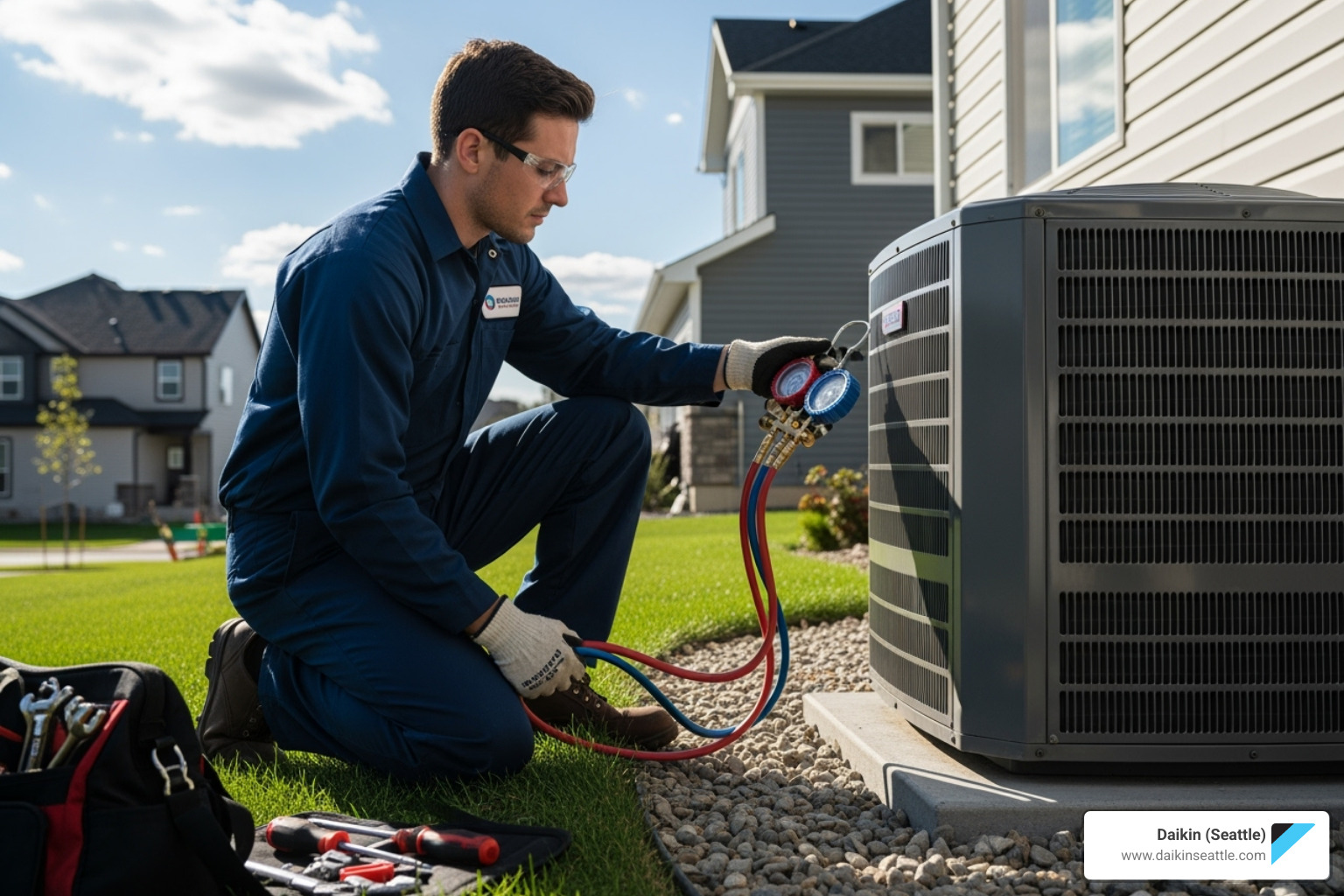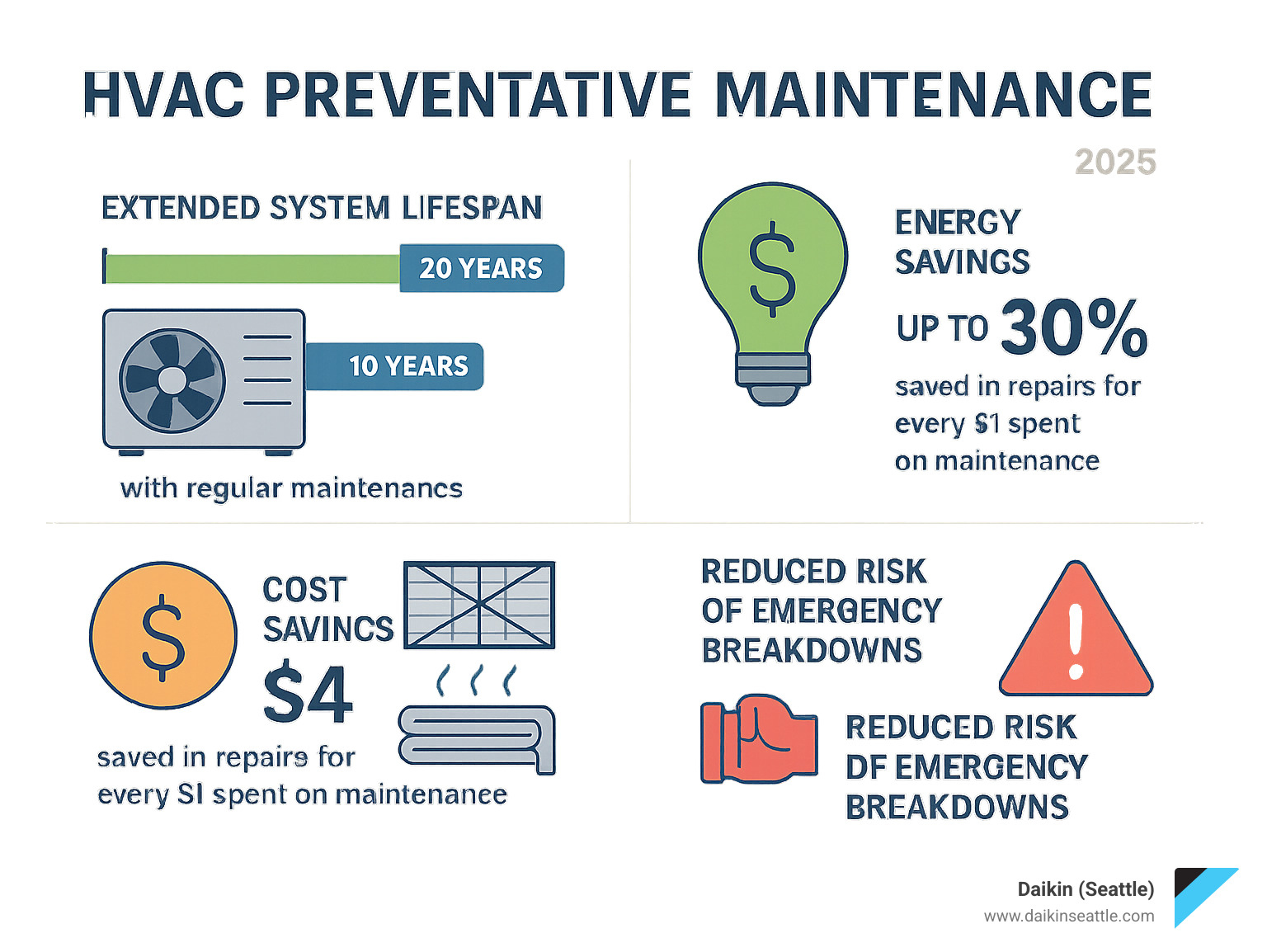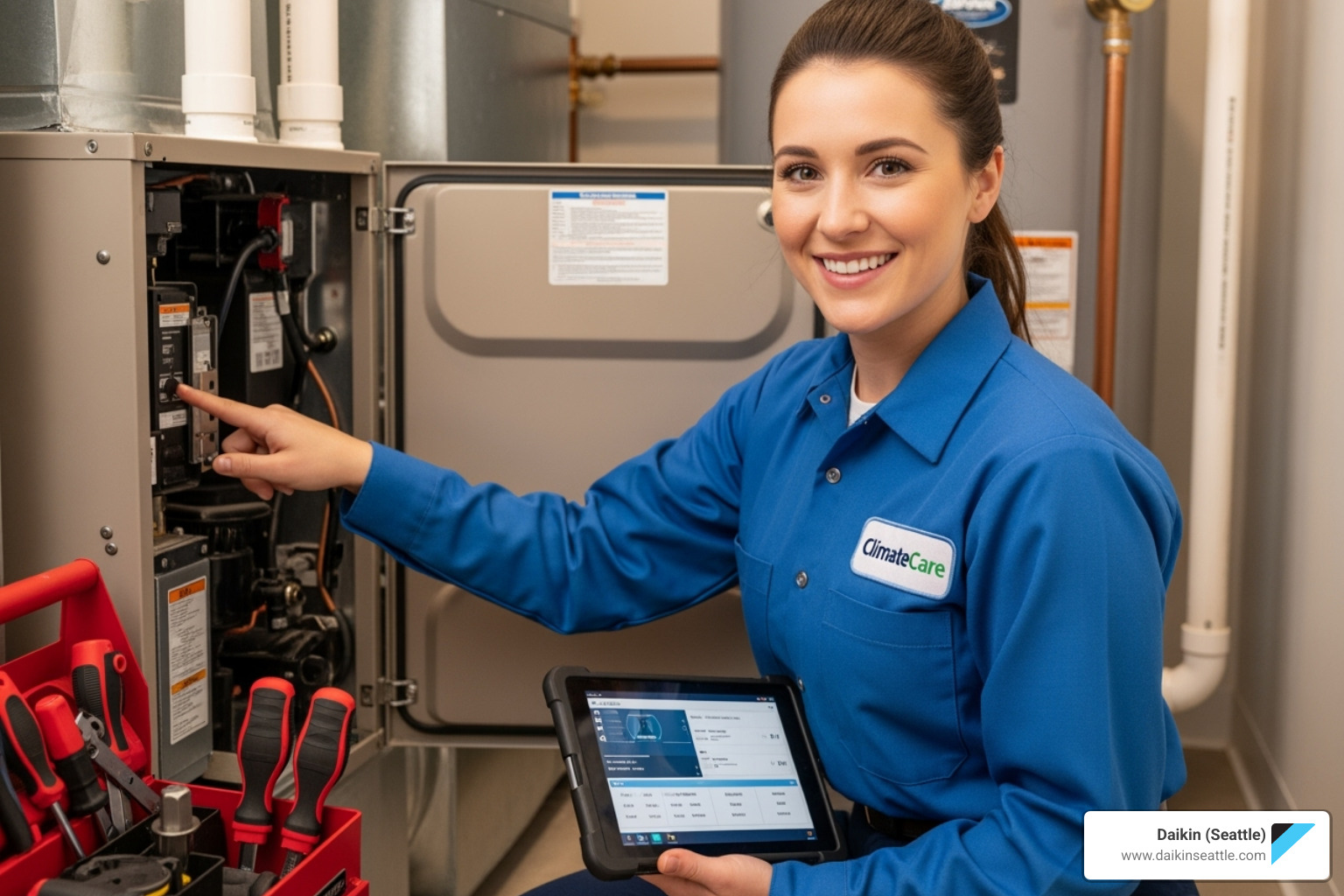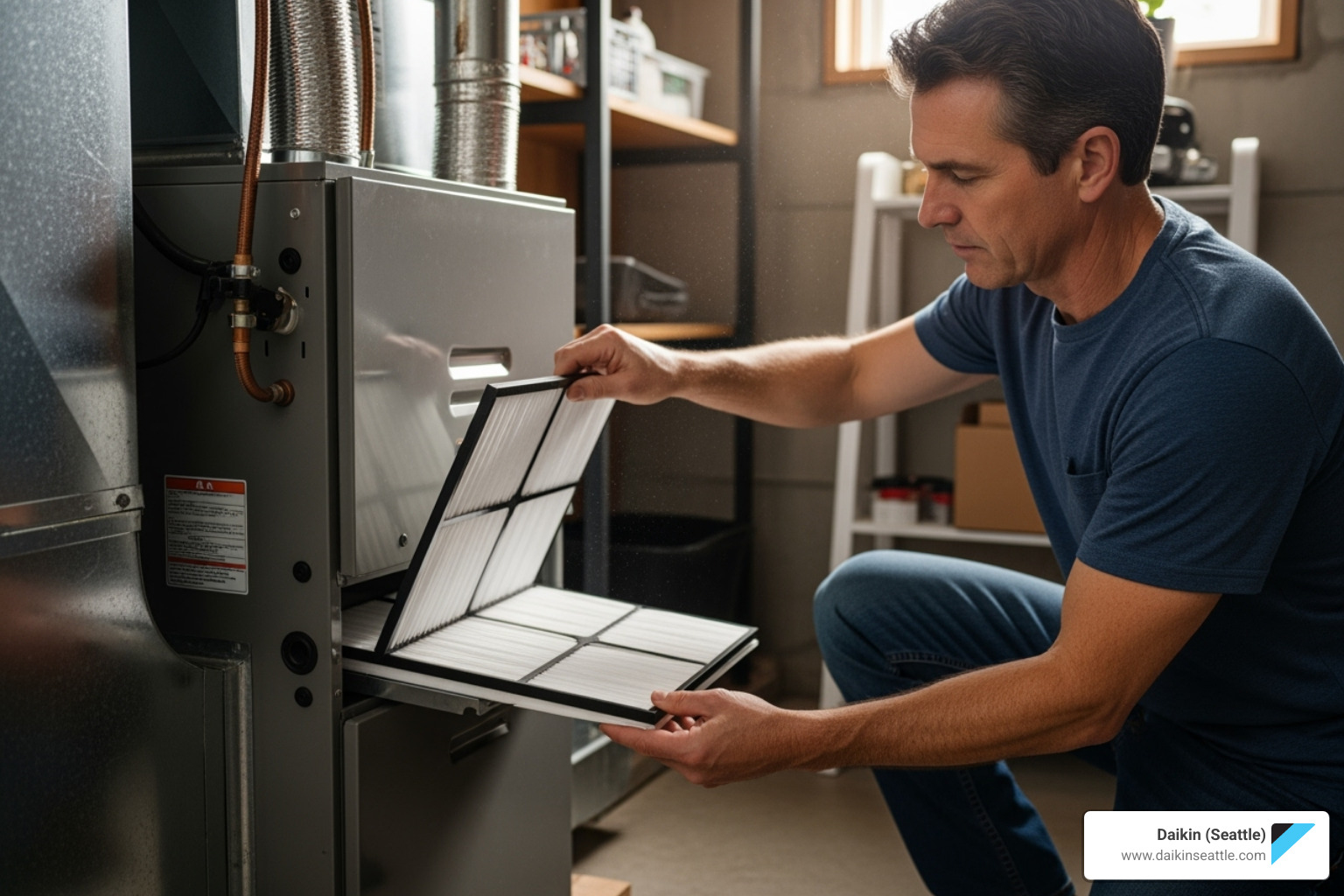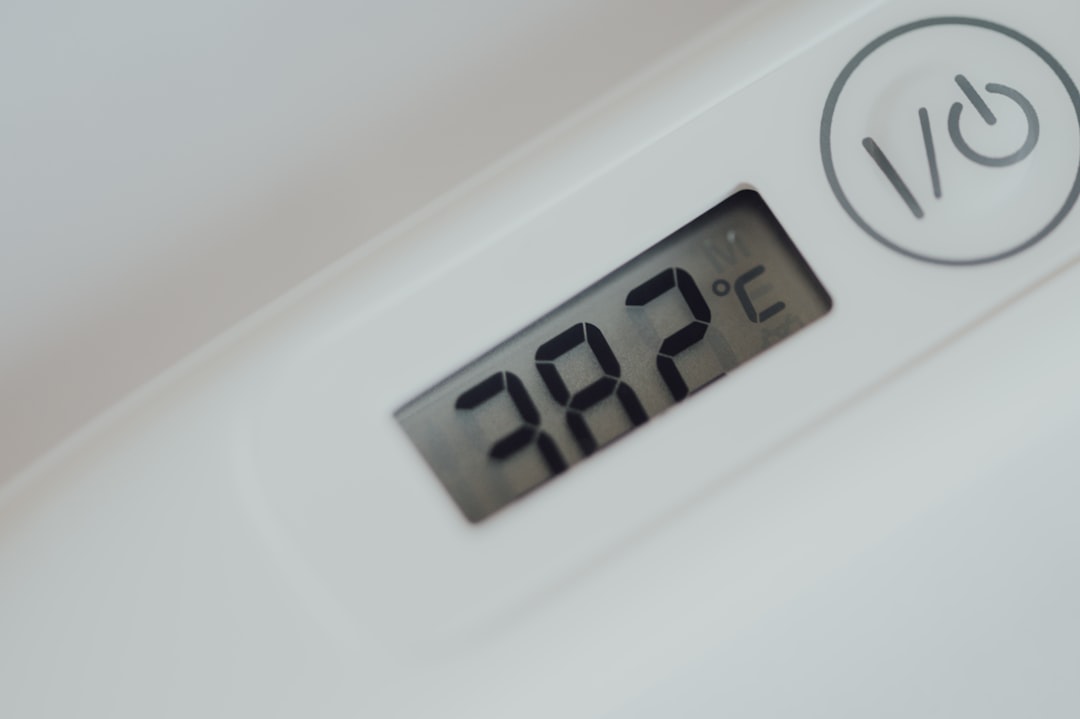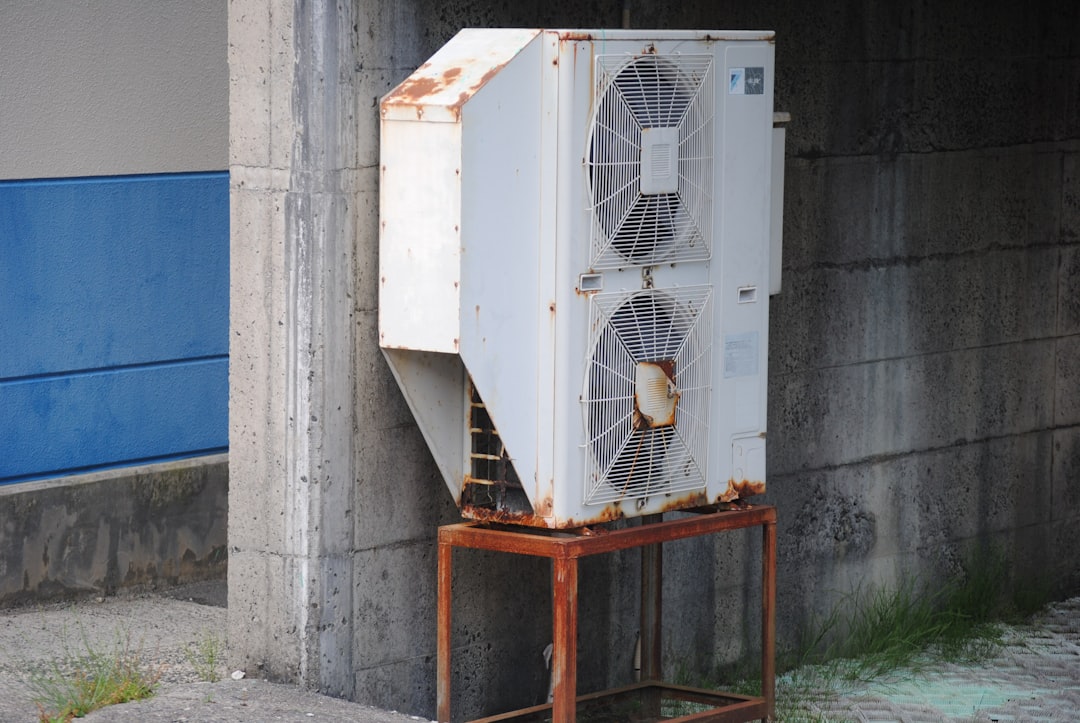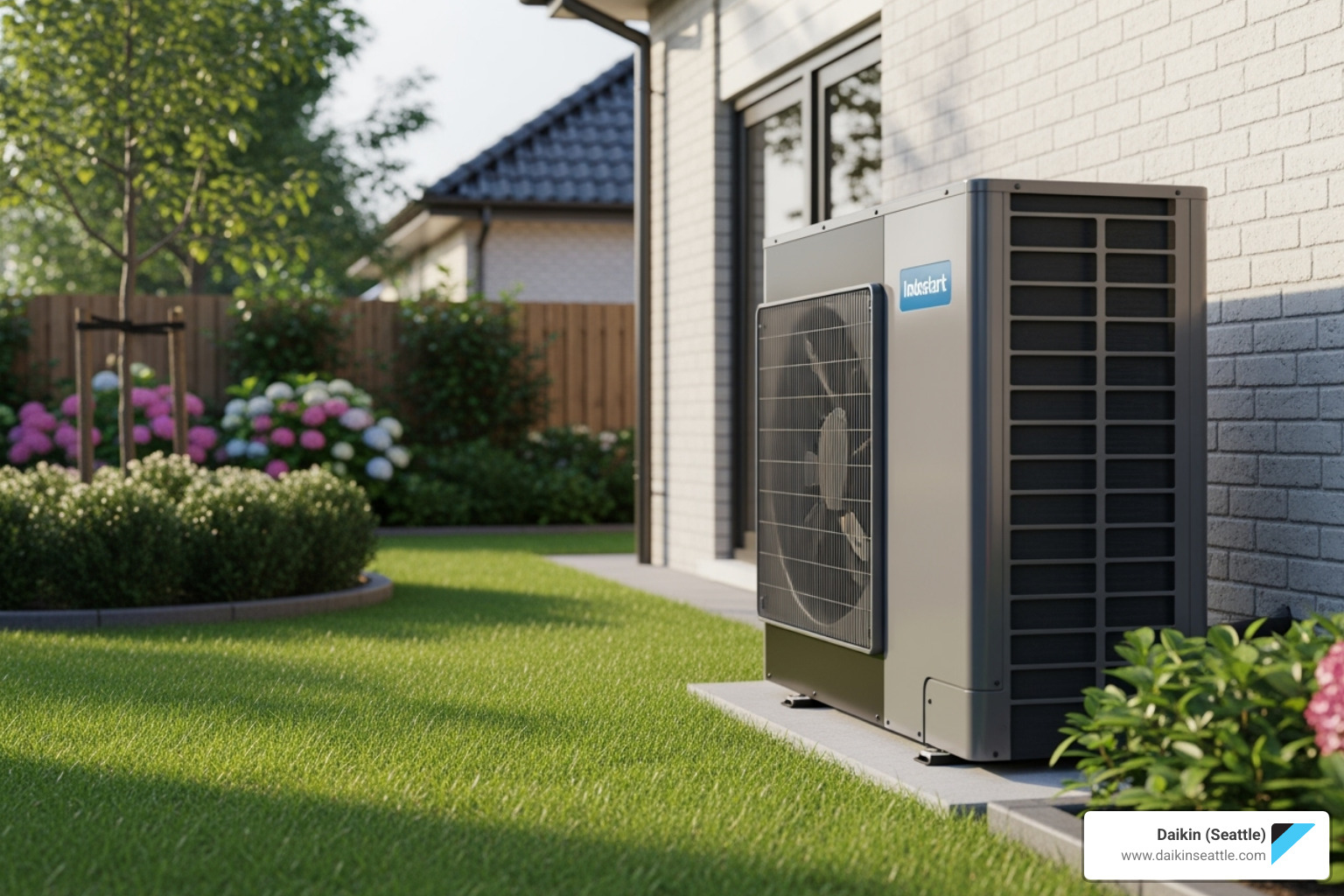Why Your HVAC System Is Your Home’s Best Investment
HVAC preventative maintenance is a proactive approach to keeping your heating and cooling system running efficiently through scheduled inspections, cleaning, and tune-ups. Here’s what you need to know:
What It Includes:
- Regular filter changes and system cleaning
- Inspection of electrical connections and moving parts
- Testing refrigerant levels and safety controls
- Seasonal tune-ups (spring for cooling, fall for heating)
Key Benefits:
- Energy savings: Up to 30% reduction in energy consumption
- Extended lifespan: Systems last 5-7 years longer with regular care
- Cost protection: Save $4 in repairs for every $1 spent on maintenance
- Better air quality: Cleaner filters and coils reduce indoor pollutants
Your HVAC system works tirelessly behind the scenes, maintaining your family’s comfort through Seattle’s varied seasons. Yet most homeowners only think about their system when something goes wrong – usually at the worst possible moment.
The difference between proactive care and reactive repairs can save you thousands of dollars and prevent those dreaded middle-of-winter breakdowns. When 75% of catastrophic system failures show early warning signs that routine maintenance would have caught, the choice becomes clear.
Preventative maintenance isn’t just smart – it’s essential. Systems that receive regular care can last 15-20 years, while neglected units may need replacement in as little as 10 years. With the average HVAC replacement costing between $5,000 and $10,000, a small investment in maintenance pays huge dividends.
What is HVAC Preventative Maintenance and Why Does It Matter?
Picture this: it’s the coldest day of winter, and your heating system decides to take an unscheduled vacation. Sound familiar? This is exactly why HVAC preventative maintenance exists – to keep those nightmare scenarios from happening in the first place.
HVAC preventative maintenance is simply taking a proactive approach to caring for your heating and cooling system. Instead of crossing your fingers and hoping everything works when you need it most, you schedule regular upkeep to keep your system running smoothly. Think of it like getting regular oil changes for your car – small investments that prevent big problems down the road.
This scheduled upkeep involves thorough inspections, cleaning, and fine-tuning to catch small issues before they turn into major headaches. The goal is straightforward: prevent breakdowns, optimize efficiency, extend your equipment’s lifespan, and ensure your family stays safe and comfortable year-round.
For homeowners in Seattle and throughout the Pacific Northwest, this means consistent comfort regardless of what Mother Nature throws your way. For businesses, it translates to happy customers and employees, plus lower operational costs and fewer unexpected disruptions.
Modern HVAC systems, especially advanced heat pumps and inverter technology, are designed for maximum efficiency and comfort. But to truly open up these benefits, regular maintenance is essential. You can learn more about how these innovative systems work by exploring our HVAC Systems Seattle solutions.
The High Cost of Neglect
Here’s the uncomfortable truth: skipping maintenance might feel like saving money today, but it’s actually setting you up for much bigger expenses tomorrow.
When your system breaks down unexpectedly, you’re looking at emergency repair calls that often cost two to three times more than regular maintenance visits. Why? Because emergencies always seem to happen at the worst possible moments – during a holiday weekend, in the middle of the night, or when every technician in town is already swamped.
But emergency repairs are just the beginning. Neglecting your system dramatically shortens its lifespan. While a well-maintained HVAC system can serve you faithfully for 15 to 20 years, a neglected one might give up after just 10 years. When replacement time comes, you’re looking at costs between $5,000 and $10,000 according to industry data from EcoWatch.
Meanwhile, your neglected system is quietly draining your bank account every month through inefficiency. Dirty coils force your system to work harder. Unlubricated parts create friction and waste energy. Faulty connections mean your system struggles to maintain the temperature you want, leading to sky-high utility bills.
It’s like trying to run a marathon with a backpack full of rocks – you’ll eventually get there, but it’s going to cost you much more energy along the way.
The Payoff: A Smart Financial Decision
Now for the good news: HVAC preventative maintenance delivers impressive returns on your investment. The numbers don’t lie – for every dollar you spend on maintenance, you can save $4 in avoided breakdown and repair costs, according to the EPA’s preventive maintenance guidance.
That’s a 400% return on investment that shows up in several ways. Fewer emergency calls means you avoid those expensive after-hours repair bills. Lower energy consumption translates directly to savings on your monthly utility bills – money you’ll notice in your pocket every month.
Extended equipment lifespan is perhaps the biggest win of all. By catching small problems early and keeping everything running smoothly, maintenance can add years to your system’s life. That means delaying a major replacement purchase by 5-7 years or more.
But beyond the dollars and cents, there’s something invaluable about peace of mind. When Seattle’s weather gets extreme – whether it’s an unexpected cold snap or a scorching summer day – you can relax knowing your system is ready to keep your family comfortable.
Regular maintenance transforms your HVAC system from a potential source of stress into a reliable partner you can count on, season after season.
Key Benefits of a Consistent Maintenance Schedule
A well-maintained HVAC system isn’t just about avoiding costly repairs; it’s about open uping a host of benefits that improve your comfort, save you money, and contribute to a healthier living or working environment.
Slash Your Energy Bills
One of the most immediate and tangible benefits of regular HVAC preventative maintenance is the significant reduction in your energy consumption and, consequently, your utility bills. An HVAC system that isn’t regularly maintained becomes inefficient. Dirty filters restrict airflow, grimy coils struggle to transfer heat, and unlubricated parts create friction, forcing the system to work harder and consume more energy to achieve the same results.
Well-maintained HVAC units can operate up to 20% more efficiently than neglected ones. The U.S. Department of Energy suggests that proper maintenance can reduce energy consumption by as much as 30%. Imagine shaving a third off your heating and cooling costs each month! This efficiency boost not only benefits your wallet but also contributes to greater sustainability, aligning with our commitment to energy-efficient and eco-friendly solutions.
To learn more about how efficient systems can make a difference in your home, we encourage you to Explore the Most Energy Efficient HVAC Systems.
Extend Your HVAC System’s Lifespan
Your HVAC system is a significant investment. Naturally, you want it to last as long as possible. Regular HVAC preventative maintenance is the secret sauce to maximizing its operational lifespan. By reducing wear and tear on components, catching minor issues like loose connections or worn belts before they cause catastrophic damage, and ensuring all parts are working in harmony, maintenance significantly extends the life of your unit.
Statistics show that systems with regular maintenance last 5-7 years longer on average. While a neglected system might need replacement in as little as 10 years, a well-maintained one can comfortably serve you for 15 to 20 years. This longevity means you get more value from your initial investment and delay the substantial cost of a full system replacement, as highlighted by industry insights from sources like ACHR News. It’s peace of mind knowing your system is built to last, especially with our advanced Daikin solutions designed for durability.
Breathe Cleaner, Healthier Air
Indoor air quality (IAQ) is a growing concern, and for good reason. Did you know that indoor air can be two to five times more polluted than outdoor air? Your HVAC system plays a crucial role in managing the air you breathe inside your home or business.
Regular HVAC preventative maintenance significantly improves indoor air quality. This includes:
- Filter Replacement: Dirty filters are a prime culprit for poor IAQ. They become clogged with dust, allergens, pet dander, and other pollutants, restricting airflow and recirculating these contaminants back into your space. Regular filter changes ensure your system can effectively trap these particles.
- Coil Cleaning: Evaporator and condenser coils can accumulate dirt, dust, and even mold, especially in our damp Pacific Northwest climate. Neglected coils can become breeding grounds for mold and bacteria, releasing spores into your air. Cleaning them prevents this buildup and ensures your system can dehumidify and cool effectively.
- Ductwork Inspection: Maintenance also involves inspecting your ductwork for leaks or blockages that could compromise air quality and efficiency.
By keeping your system clean and running optimally, we help reduce the circulation of allergens, dust, mold, and other pollutants, creating a healthier, more comfortable indoor environment for your family or employees. Our commitment to your well-being extends to providing comprehensive Learn about Indoor Air Quality Solutions Seattle that integrate seamlessly with your HVAC system, supporting the guidance from reputable sources like The U.S. Environmental Protection Agency.
Your Essential HVAC Maintenance Checklist
To ensure your HVAC system performs optimally year-round, a clear and comprehensive maintenance checklist is invaluable. It helps us systematically address all critical components, ensuring nothing is overlooked. We separate tasks homeowners can easily handle from those requiring the specialized tools and expertise of a professional technician. For a broader perspective on maintenance, you can also consult A detailed maintenance checklist from Energy Star.
DIY HVAC Preventative Maintenance Tasks
While professional tune-ups are essential, there are several simple yet impactful tasks you can perform regularly to contribute to your system’s health and efficiency. These are your first line of defense against common issues:
- Change air filters monthly, or at least every 1-3 months, depending on usage, pet ownership, and indoor air quality needs. This is arguably the most important DIY task.
- Clear debris from around the outdoor unit. Leaves, grass clippings, and other clutter can block airflow and reduce efficiency. Ensure at least two feet of clear space around the unit.
- Keep indoor vents and registers clean and unblocked. Make sure furniture, curtains, or rugs aren’t obstructing airflow from supply or return vents.
- Check thermostat batteries and ensure settings are appropriate for the season. Consider upgrading to a smart thermostat for optimal efficiency and control.
- Visually inspect for obvious issues, such as visible leaks, strange smells, or unusual noises. Catching these early can prevent bigger problems.
Professional HVAC Preventative Maintenance Checklist
For the more intricate and critical aspects of maintenance, trust our certified technicians. We conduct thorough, seasonal tune-ups designed to prepare your system for the demands of cooling or heating.
| Task Category | Spring (Cooling) Tune-up | Fall (Heating) Tune-up |
|---|---|---|
| Cooling Specific | – Clean Evaporator & Condenser Coils: Removes dirt and grime that impede heat transfer, ensuring efficient cooling and preventing compressor strain. | (N/A) |
| – Check Refrigerant Levels: Ensures proper charge for optimal cooling. Low levels can indicate a leak and lead to inefficient operation and potential compressor damage. | (N/A) | |
| – Inspect Condensate Drain: Clears blockages from algae or debris to prevent water damage and high indoor humidity. | (N/A) | |
| – Clean Blower Components: Ensures proper airflow for efficient cooling and heating distribution. | – Clean Blower Components: Ensures proper airflow for efficient heating and cooling distribution. | |
| Heating Specific | (N/A) | – Inspect Heat Exchanger: Checks for cracks or damage that could lead to dangerous carbon monoxide leaks. |
| (N/A) | – Check Gas Connections & Pressure: Ensures safe and proper operation of gas-fired furnaces, preventing fire hazards and optimizing combustion. | |
| (N/A) | – Clean Burners: Removes soot and debris for efficient combustion and prevents uneven heating. | |
| (N/A) | – Test Safety Controls: Verifies that limit switches, pressure switches, and emergency shut-offs are functioning correctly for safe operation. | |
| Both Cooling & Heating | – Tighten Electrical Connections: Loose connections can cause voltage drops, unsafe operation, and reduce component lifespan. We measure voltage and current on motors. | – Tighten Electrical Connections: Ensures safe operation and prevents potential electrical hazards. |
| – Lubricate Moving Parts: Reduces friction, minimizes wear and tear, and ensures smooth, quiet operation. | – Lubricate Moving Parts: Essential for the longevity of motors and fans. | |
| – Test Thermostat Calibration: Ensures accurate temperature readings and proper system control, optimizing comfort and energy savings. | – Test Thermostat Calibration: Critical for maintaining desired indoor temperatures efficiently. |
How Often Should Maintenance Be Performed?
For most HVAC systems, we strongly recommend bi-annual maintenance: once in the spring to prepare your cooling system for the warmer months, and once in the fall to get your heating system ready for the colder season. This schedule ensures that your system is always optimized for the demands of the upcoming weather.
However, the ideal frequency can be influenced by several factors:
- System Age: Older systems might benefit from more frequent checks.
- Climate: Our varied climate in the Pacific Northwest means your system works hard year-round.
- Usage: Systems in homes with constant occupancy or businesses with high demands may require more frequent attention.
- Manufacturer Recommendations: Adhering to manufacturer guidelines is crucial, especially for warranty validity.
- Specific Needs: If you have allergies, pets, or a commercial property, more frequent filter changes or coil cleanings might be necessary.
This bi-annual approach helps us proactively detect and rectify potential issues, ensuring your system runs efficiently and reliably. We specialize in tailoring HVAC solutions to meet the unique needs of homes and businesses across Seattle, Tukwila, and the wider Washington area. Find more about how we can help you find the right Find the right HVAC Solutions in Seattle for your property.
Warning Signs Your System Needs Attention
Your HVAC system has its own way of talking to you – and trust me, it’s not shy about letting you know when something’s wrong! Even with regular HVAC preventative maintenance, staying alert to these early warning signs can save you from bigger headaches (and bigger bills) down the road.
Listen for unusual noises that weren’t there before. Your system should hum along quietly in the background, not announce its presence with a symphony of concerning sounds. Grinding often signals a motor bearing that’s on its last legs, while squealing typically means a belt is crying out for help or replacement. Rattling could be loose panels or screws, and persistent banging might indicate serious internal damage. These aren’t sounds you want to ignore – they’re your system’s way of asking for immediate attention.
Pay attention to strange odors wafting from your vents. A burning smell should always be taken seriously, as it might indicate electrical problems or dust burning off heating elements during startup. Musty or moldy odors are red flags for moisture buildup somewhere in your system, possibly in the ductwork or around the coils. This isn’t just unpleasant – it can affect your family’s health and indicates your system needs professional cleaning.
Notice changes in airflow throughout your home. If some rooms feel like they’re in a different climate zone than others, or if the air coming from your vents feels weak and lackluster, something’s not right. This could be as simple as a dirty filter restricting airflow, or as complex as ductwork issues or a struggling blower motor.
Watch your utility bills like a hawk. When your energy costs suddenly spike without any change in your usage patterns, your HVAC system is likely working overtime to maintain comfort. This inefficiency is often the first sign that components need attention before they fail completely.
Monitor for short cycling – that annoying pattern where your system turns on and off repeatedly without completing full heating or cooling cycles. This puts tremendous strain on your equipment and wastes energy while failing to maintain consistent comfort.
Check for water leaks or excess moisture around your indoor unit. Puddles, excessive condensation, or unexplained moisture can signal clogged drain lines, frozen coils, or refrigerant leaks – all issues that can lead to water damage and create perfect conditions for mold growth.
The key is acting quickly when you notice these warning signs. What starts as a minor issue can quickly escalate into a major system failure, especially during peak heating or cooling season when you need your system most.
Frequently Asked Questions about HVAC Maintenance
When it comes to HVAC preventative maintenance, we hear the same thoughtful questions time and again from homeowners and business owners across Seattle. These concerns are completely understandable – after all, your HVAC system is a significant investment, and you want to make sure you’re caring for it properly. Let’s explore the most common questions to help you feel confident about your system’s care.
Is preventative maintenance required to keep my warranty valid?
Here’s the short answer: yes, absolutely. Most HVAC manufacturers – including those behind our advanced Daikin solutions – require documented proof of regular professional maintenance to honor warranty claims. Think about it from their perspective: they know that a well-maintained system is far less likely to experience premature failure.
The reality is stark. Neglecting maintenance can void your coverage entirely, leaving you holding the bag for expensive repair costs that would otherwise be covered. We’ve seen homeowners face thousands of dollars in out-of-pocket expenses simply because they couldn’t provide maintenance records when filing a warranty claim.
While specific requirements vary by manufacturer, the general rule is straightforward: schedule professional tune-ups annually or bi-annually, keep your receipts, and document any maintenance work performed. It’s a small price to pay for protecting your investment and ensuring you can take advantage of your warranty protection when you need it most.
What’s the difference between a heating and a cooling tune-up?
While both tune-ups involve thorough inspections and cleaning, they focus on different components to prepare your system for seasonal demands.
A cooling tune-up in spring zeroes in on your air conditioner’s components. Our technicians check refrigerant levels and pressure, clean both the outdoor condenser coils and indoor evaporator coils, inspect the condensate drain for clogs, and ensure blower components are spotless and functioning efficiently. The goal is optimal cooling performance and proper dehumidification during those warm Pacific Northwest summers.
A heating tune-up in fall shifts attention to your furnace or heat pump’s heating elements. This involves inspecting the heat exchanger for cracks (a critical safety check for gas furnaces to prevent carbon monoxide leaks), checking gas connections and pressure, cleaning burners for efficient combustion, and testing all safety controls. For heat pumps, we ensure the system is ready to efficiently extract heat from outside air, even on chilly Seattle mornings.
Both seasonal tune-ups include essential year-round tasks like tightening electrical connections, lubricating moving parts, and calibrating your thermostat – all vital for safe, efficient operation regardless of the season.
Can I perform all HVAC maintenance myself?
We absolutely encourage homeowners to tackle simple DIY tasks like regularly changing air filters and keeping the outdoor unit clear of debris. These small efforts make a real difference in your system’s performance and show you’re invested in its care.
However, when it comes to the complex and potentially dangerous aspects of HVAC preventative maintenance, professional expertise is non-negotiable. Many HVAC components involve high-voltage electricity, pressurized refrigerants, or natural gas lines – all requiring specialized tools, extensive training, and years of experience to handle safely.
Attempting tasks beyond your skill level isn’t just risky – it can be downright dangerous. We’ve seen well-intentioned DIY efforts lead to personal injury, significant system damage, and even create fire or carbon monoxide hazards. Tasks like checking refrigerant levels, inspecting electrical connections, cleaning coils with specialized solutions, or examining heat exchangers should always be left to certified professionals.
Our technicians bring the knowledge, experience, and proper equipment to safely diagnose and address issues, ensuring your system operates at peak performance while keeping your family safe.
Conclusion
Think of your HVAC system as your home’s silent guardian – always there, working tirelessly to keep you comfortable through Seattle’s unpredictable weather. Whether it’s battling the winter chill or cooling you down during those surprisingly warm summer days, this hardworking system deserves our attention and care.
HVAC preventative maintenance isn’t just another item on your home care checklist; it’s one of the smartest investments you can make. We’ve seen how this proactive approach delivers incredible returns: cost savings that can reach $4 for every dollar spent, extended system longevity of 5-7 additional years, improved efficiency that can cut your energy bills by up to 30%, and healthier indoor air that benefits your entire family.
Here’s the truth: preventative maintenance isn’t an expense you grudgingly pay – it’s a strategic decision that protects both your comfort and your bank account. By catching those small hiccups before they turn into major headaches, you’re avoiding those dreaded emergency repair calls and postponing the need for a costly system replacement.
The peace of mind alone is worth it. No more worrying about your system failing during the coldest snap of winter or the hottest day of summer. Instead, you get to enjoy consistent comfort, watch your energy bills shrink, and breathe cleaner air – all while knowing your system is built to last.
For comprehensive care and expertise with advanced Daikin HVAC Solutions in Seattle, our professional team is here to help. We understand your system inside and out, and we’re committed to keeping it running at peak performance year-round.
Don’t wait for that inevitable breakdown to remind you how important your HVAC system really is. Take control of your comfort and schedule your maintenance today. Your future self (and your wallet) will thank you. And if you’re considering upgrading to more efficient cooling options, we invite you to Learn more about our ductless air conditioner solutions in Seattle – they pair beautifully with a solid maintenance routine.

